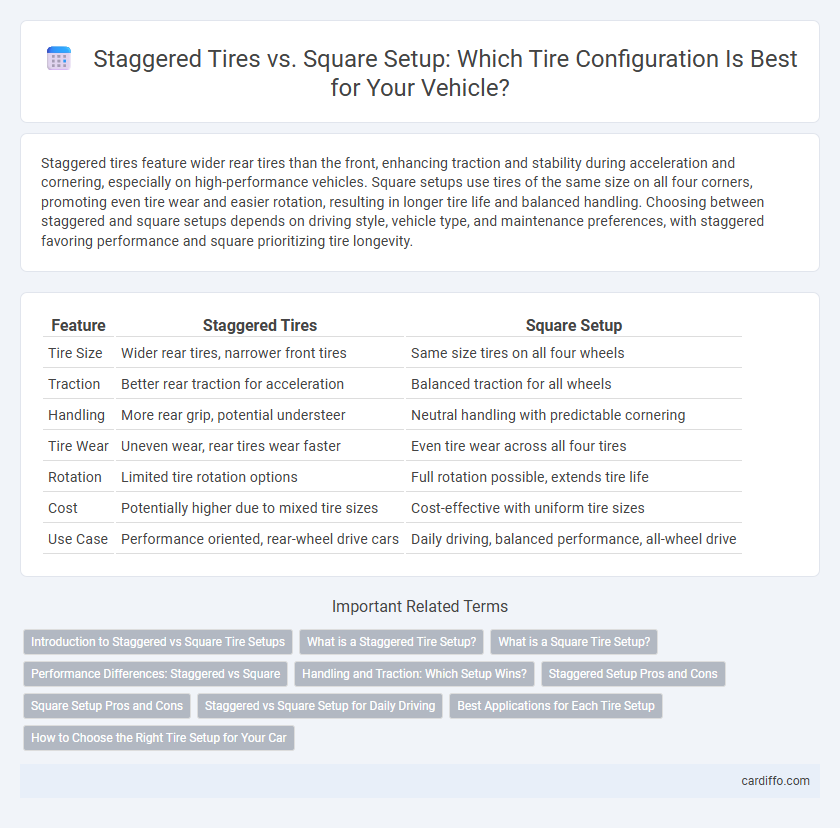Staggered tires feature wider rear tires than the front, enhancing traction and stability during acceleration and cornering, especially on high-performance vehicles. Square setups use tires of the same size on all four corners, promoting even tire wear and easier rotation, resulting in longer tire life and balanced handling. Choosing between staggered and square setups depends on driving style, vehicle type, and maintenance preferences, with staggered favoring performance and square prioritizing tire longevity.
Table of Comparison
| Feature | Staggered Tires | Square Setup |
|---|---|---|
| Tire Size | Wider rear tires, narrower front tires | Same size tires on all four wheels |
| Traction | Better rear traction for acceleration | Balanced traction for all wheels |
| Handling | More rear grip, potential understeer | Neutral handling with predictable cornering |
| Tire Wear | Uneven wear, rear tires wear faster | Even tire wear across all four tires |
| Rotation | Limited tire rotation options | Full rotation possible, extends tire life |
| Cost | Potentially higher due to mixed tire sizes | Cost-effective with uniform tire sizes |
| Use Case | Performance oriented, rear-wheel drive cars | Daily driving, balanced performance, all-wheel drive |
Introduction to Staggered vs Square Tire Setups
Staggered tire setups feature wider rear tires than the front, enhancing traction and handling for rear-wheel-drive vehicles during acceleration and cornering. Square setups use tires of the same size on all four wheels, promoting even wear and simplified rotation, improving tire longevity and balanced performance. Choosing between staggered and square setups depends on driving style, vehicle drivetrain, and desired handling characteristics.
What is a Staggered Tire Setup?
A staggered tire setup features larger, wider tires on the rear axle compared to narrower tires on the front, enhancing traction and handling in performance vehicles. This configuration improves rear grip during acceleration and provides a more aggressive stance while optimizing cornering stability. Staggered setups are common in sports cars and rear-wheel-drive vehicles for superior balance between control and aesthetics.
What is a Square Tire Setup?
A square tire setup features identical tire sizes on all four wheels, optimizing uniform contact patch and consistent handling balance on various road surfaces. This configuration enhances stability, cornering precision, and tire wear predictability, especially beneficial in daily driving or balanced performance scenarios. Unlike staggered setups, square setups allow tire rotation between front and rear, extending tire life and maintaining balanced traction.
Performance Differences: Staggered vs Square
Staggered tires, featuring wider tires on the rear axle, enhance traction and cornering stability by maximizing rear grip, especially in high-performance rear-wheel-drive vehicles. A square setup, using identical tires on all four wheels, promotes balanced handling and even tire wear, improving overall stability and predictable steering response. Performance differences highlight staggered setups excelling in straight-line acceleration and rear grip, while square setups offer superior versatility and consistent performance in both cornering and braking.
Handling and Traction: Which Setup Wins?
Staggered tires, with wider rear tires and narrower fronts, enhance traction by providing a larger contact patch during acceleration, improving straight-line grip. Square setups, using equal tire widths front and rear, offer balanced handling and predictable cornering dynamics due to uniform tire grip and more even wear patterns. For aggressive cornering and superior handling, square setups typically win, while staggered tires excel in traction during acceleration and high-power applications.
Staggered Setup Pros and Cons
Staggered tire setups feature larger wheels and tires on the rear axle compared to the front, enhancing traction and handling performance in rear-wheel-drive vehicles. This configuration improves cornering stability and aggressive styling but limits tire rotation options, leading to uneven tire wear and potentially higher replacement costs. Staggered setups are ideal for performance enthusiasts seeking improved grip but require careful maintenance to avoid premature tire degradation.
Square Setup Pros and Cons
Square tire setups feature identical tire sizes on all four wheels, offering improved handling balance and easier tire rotation for extended tread life. This configuration often results in more predictable cornering and better traction in everyday driving conditions, especially for vehicles prioritizing comfort and efficiency. However, square setups can limit customization for specialized performance needs and may not provide the enhanced grip or stability found in staggered arrangements used in high-performance or rear-wheel-drive vehicles.
Staggered vs Square Setup for Daily Driving
Staggered tires feature wider rear tires and narrower front tires, providing better traction and handling during cornering, which benefits daily driving on varied road conditions. Square setups use identical tire sizes on all four wheels, offering easier tire rotation, more uniform wear, and often improved longevity, making them practical for everyday use. For daily driving, the square setup typically delivers a balanced ride experience with reduced maintenance complexity compared to staggered setups.
Best Applications for Each Tire Setup
Staggered tire setups, featuring wider rear tires and narrower fronts, excel in high-performance rear-wheel-drive vehicles by enhancing traction during acceleration and improving cornering stability. Square setups, where all four tires are the same size, offer more uniform tire wear, easier rotation, and balanced handling, making them ideal for daily driving and all-wheel-drive cars. Off-road and track enthusiasts benefit from staggered setups for optimal grip, while square setups serve better in situations requiring tire interchangeability and consistent performance.
How to Choose the Right Tire Setup for Your Car
Choosing the right tire setup depends on your driving style, vehicle type, and performance goals. Staggered tires, featuring wider rear tires, enhance traction and cornering for rear-wheel-drive sports cars but may wear unevenly and limit tire rotation options. A square setup with equal tire sizes on all wheels offers balanced grip, improved tire longevity, and easier maintenance, ideal for track driving and all-wheel-drive vehicles.
Staggered tires vs Square setup Infographic

 cardiffo.com
cardiffo.com